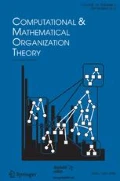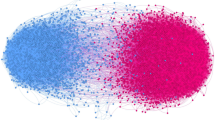Abstract
This paper proposes a new formal modeling approach to popularity dynamics based on a generic notion of message propagation within society. The approach is demonstrated with two original models of information diffusion. These are a branching model of popularity and a epidemic model of popularity. The first is based on the principles of a branching process, while the second emulates an epidemic equation with a specific infection rate. This allows us to consider the replication phenomena on information diffusion. The approach is validated using a very large dataset collected online that involves keywords in blogs and hashtags on Twitter. Our main results point to an overall good fit of both models, both when the process of popularity grows and when it decays. This is due to endogenous information transfer, as in an epidemic process, but also when the process is initially triggered by an external event. Overall, on balance, our models confirm that popularity builds through message diffusion, which is of the multiplicative kind.













Similar content being viewed by others
Notes
Therefore, particular conditions of message propagation within the social network are not considered in this paper. Moreover, in our case study particular topologies of the network are not considered either.
This branching model is partially inspired by the resolution steps presented in Sornette et al. (2004).
References
Ahmed M, Spagna S, Huici F, Niccolini S (2013) A peek into the future: predicting the evolution of popularity in user generated content. In: Proceedings of the sixth ACM international conference on Web search and data mining. ACM, pp 607–616
Anderson RM, May RM (1991) Infectious diseases of humans, vol 1. Oxford University Press, Oxford
Bandari R, Asur S, Huberman BA (2012) The pulse of news in social media: forecasting popularity. In: ICWSM
Buckley PG, Osthus D (2004) Popularity based random graph models leading to a scale-free degree sequence. Discret Math 282(1–3):53–68
Castillo C, El-Haddad M, Pfeffer J, Stempeck M (2014) Characterizing the life cycle of online news stories using social media reactions. In: Proceedings of the 17th ACM conference on Computer supported cooperative work & social computing. ACM, pp 211–223
Couronne T, Beuscart JS, Chamayou C (2013) Self-organizing map and social networks: unfolding online social popularity. arXiv:1301.6574
Easley D, Kleinberg J (2010) Networks, crowds, and markets: reasoning about a highly connected world. Cambridge University Press, Cambridge
Fonseca A (2013) Ways of communicating. In: NESS conference on media opinion dynamics—ICT applications to non-equilibrium social sciences. ISCTE-IUL
Gao S, Ma J, Chen Z (2014) Popularity prediction in microblogging network. In: Web technologies and applications. Springer, Berlin, pp 379–390
Gruhl D, Guha R, Liben-Nowell D, Tomkins A (2004) Information diffusion through blogspace. In: Proceedings of the 13th international conference on World Wide Web. ACM, pp 491–501
Gupta M, Gao J, Zhai C, Han J (2012) Predicting future popularity trend of events in microblogging platforms. Proc Am Soc Inf Sci Technol 49(1):1–10
Hong L, Dan O, Davison BD (2011) Predicting popular messages in twitter. In: Proceedings of the 20th international conference companion on World wide web. ACM, pp 57–58
Kim SD, Kim SH, Cho HG (2011) Predicting the virtual temperature of web-blog articles as a measurement tool for online popularity. In: Computer and information technology (CIT), 2011 IEEE 11th international conference on. IEEE, pp 449–454
Kong S, Feng L, Sun G, Luo K (2012) Predicting lifespans of popular tweets in microblog. In: Proceedings of the 35th international ACM SIGIR conference on Research and development in information retrieval. ACM, pp 1129–1130
Kong S, Mei Q, Feng L, Ye F, Zhao Z (2014a) Predicting bursts and popularity of hashtags in real-time. In: Proceedings of the 37th international ACM SIGIR conference on Research & development in information retrieval. ACM, pp 927–930
Kong S, Mei Q, Feng L, Zhao Z, Ye F (2014b) On the real-time prediction problems of bursting hashtags in twitter. arXiv:1401.2018
Lin Y-R, Keegan B, Margolin D, Lazer D (2014) Rising tides or rising stars?: dynamics of shared attention on twitter during media events. PloS ONE 9(5):e94093
Lin YR, Margolin D, Keegan B, Baronchelli A, Lazer D (2013) # bigbirds never die: understanding social dynamics of emergent hashtag. arXiv:1303.7144
Ma Z, Sun A, Cong G (2012) Will this# hashtag be popular tomorrow? In: Proceedings of the 35th international ACM SIGIR conference on Research and development in information retrieval. ACM, pp 1173–1174
Ma Z, Sun A, Cong G (2013) On predicting the popularity of newly emerging hashtags in twitter. J Am Soc Inf Sci Technol 64(7):1399–1410
Matsubara Y, Sakurai Y, Prakash BA, Li L, Faloutsos C (2012) Rise and fall patterns of information diffusion: model and implications. In: Proceedings of the 18th ACM SIGKDD international conference on Knowledge discovery and data mining. ACM, pp 6–14
Petrovic S, Osborne M, Lavrenko V (2011) Rt to win! predicting message propagation in twitter. In: ICWSM
Pinto H, Almeida JM, Gonçalves MA (2013) Using early view patterns to predict the popularity of youtube videos. In: Proceedings of the sixth ACM international conference on Web search and data mining. ACM, pp 365–374
Ratkiewicz J, Fortunato S, Flammini A, Menczer F, Vespignani A (2010) Characterizing and modeling the dynamics of online popularity. Phys Rev Lett 105(15):158701
Shamma D, Kennedy L, Churchill E (2010) Tweetgeist: can the twitter timeline reveal the structure of broadcast events. CSCW Horizons
Shannon CE, Weaver W (1949) The mathematical theory of communication. The University of Illinois Press, Urbana, IL
Sornette D, Deschâtres F, Gilbert T, Ageon Y (2004) Endogenous versus exogenous shocks in complex networks: an empirical test using book sale rankings. Phys Rev Lett 93(22):228701
Szabo G, Huberman BA (2010) Predicting the popularity of online content. Commun ACM 53(8):80–88
Tatar A, Leguay J, Antoniadis P, Limbourg A, de Amorim MD, Fdida S (2011) Predicting the popularity of online articles based on user comments. In: Proceedings of the International Conference on Web Intelligence, Mining and Semantics. ACM, p 67
Yang J, Leskovec J (2011) Patterns of temporal variation in online media. In:Proceedings of the fourth ACM international conference on Web search and data mining, pp 177–186
Author information
Authors and Affiliations
Corresponding author
Rights and permissions
About this article
Cite this article
Fonseca, A., Louçã, J. Explaining the emergence of online popularity through a model of information diffusion. Comput Math Organ Theory 24, 169–187 (2018). https://doi.org/10.1007/s10588-017-9253-5
Published:
Issue Date:
DOI: https://doi.org/10.1007/s10588-017-9253-5




